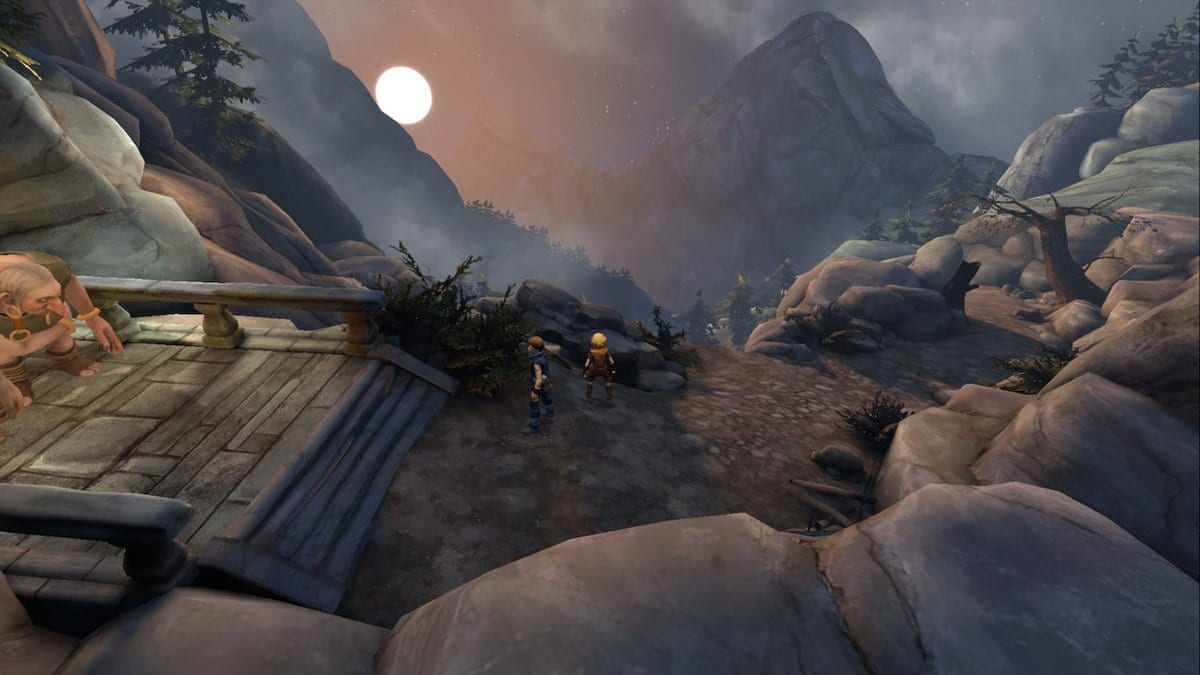Brothers: A Tale of Two Sons is a bit of an odd name to pop up as a new release, considering its initial 2013 launch date and lack of buzz since. The 505 Games release did receive a fair bit of hype at the time, generated in part by its careful storytelling but in bulk by its unique control scheme. The latter asked the player to manage two separate characters on one gamepad, dedicating an analog stick and a trigger to each. Over the course of the near-six-year interim between its arrival on the Xbox 360 store and its recent appearance on Switch, I never did get around to buying and playing the game, despite a cheap price tag and an appealing art style. Now that I’ve finally gotten my hands on it, I know I was missing out.
More than anything else, Brothers calls to mind Fumito Ueda’s games — Ico, Shadow of the Colossus and The Last Guardian. Brothers is a more minor affair than any of these, lasting only a few hours and focusing on more manageable ambitions, but it still takes some of the most important lessons from Ueda to heart. There’s no decipherable dialogue from the characters, but their Sim-like mutterings still manage to convey clear intent and genuine emotion. Brothers typically features no UI, with only introductory control scheme pop-ups, small loading icons and an infrequent achievement system. For the vast majority, you’re left to experience it as organically as possible, poking around at the surprisingly large (but linear) world without button prompts or any other distractions. The very occasional loading times are just quick cuts to black on the Switch and only occur when moving between large areas or occasionally in and out of buildings.
Overall, the Switch port looks and plays quite well both docked and undocked, running at max resolution on both options with a consistently smooth frame rate. It plays comfortably with the Pro Controller, but using separate Joy-Cons also provides an interesting option if you want more mental distinction between the two characters you’re controlling. Joy-Cons also allows for seamless swapping to co-op play without any awkward controller sharing. As a side note, the Switch is also the first platform to offer a specific multiplayer option, which you can select from the main menu if you want to designate controllers beyond swapping Joy-Cons. The generally pleasant nature of the Switch port, however, does not extend into a perfect experience. One visual bug that rendered a rope ramrod straight instead of slack made a particularly somber moment strangely goofy. The shadows of characters usually look fine, but whenever they overlap, they reveal strange outlines. One view from a bench revealed water that looked clearly unfinished at the foot of the cliff. None of these are major issues, and on the whole I’d still recommend the port. As far as I can tell though, these problems aren’t usually present in the PC version.
In a larger sense, where Brothers generally falls short compared to Ueda’s games or other puzzlers is in the simplicity of figuring out its tasks. Despite some clever progressions of puzzle mechanics, nothing in Brothers ever manages to particularly challenge the player’s deductive capabilities. The objectives are presumably kept simple so that the control mechanics never become frustrating, but it ultimately makes certain segments feel rote. You spend a good deal more time simply executing the solutions to puzzles than you do actually figuring them out.
However, the progression of the environments and story keep Brothers from ever feeling like drudgery. The world is lovely and occasionally surprising, and although the progression of the story is often subtle, it offers its fair share of emotional moments. These all culminate in a final sequence that perfectly brings home the ideas of the game, playing with both the story and mechanics to create a genuinely affecting ending. If there’s a point where Brothers truly can go blow-to-blow with an Ueda game, it’s here.
A number of small pleasures along the way help to round out the satisfying experience. Simple interactions with other characters bring out charming bits of the brothers’ character traits and help to make the world feel alive. The choice to have the player control both main characters eliminates the potential struggle with an AI secondary character (I’m looking at you, Last Guardian), and the infrequent collaboration with other AI along the way is never buggy due to the simple nature of their tasks. And dear God am I thankful that Brothers doesn’t allow you to fall off most platforms. Even if they come at the cost of simple puzzling, the obvious commitment to avoiding extraneous frustration in areas like these allows the beautiful experiences in the game to envelop the player without any controller throwing along the way. The final verdict for the game is reasonably obvious. If you’re looking for hardcore brain-teasing, this isn’t your thing. But if you’re compelled by unique gameplay ideas, engaging worlds, or quiet but genuinely compelling storytelling, Brothers is definitely not one to write off.
Ben reviewed Brothers: A Tale of Two Sons on the Nintendo Switch using a code provided by the developer. The game is also available on Xbox 360, Xbox One, PlayStation 3, PlayStation 4, iOS, Android and PC.
